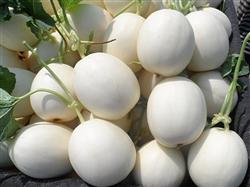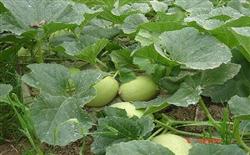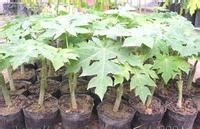Open field cultivation of thin-skinned muskmelon

Muskmelon cultivated in open field has always adopted the cultivation method of climbing vines on the ground, which is disorderly interspersed with melons, which is difficult to manage and the yield is low. If you plant melons like cucumbers, it will have a lot of benefits. First, it can be closely planted. Taking Hongcheng No. 7 muskmelon as an example, the row spacing of vine-climbing plants on the ground is 50 cm × 65 cm, the density is 2050 plants / mu, and the planting density on the shelf can reach 2850 plants / mu. The yield per mu of climbing vine cultivation is generally 3000 kg, while the yield per mu on the shelf can reach 5000 kg; third, less pollution, light diseases and insect pests. After the melon vines are on the shelf, the ventilation conditions in the garden are greatly improved, which is conducive to the full use of light energy, and because most of the leaves are higher from the ground and light pollution, so the diseases and insect pests are lighter; fourth, save labor and time. After the melon vine is on the shelf, the management is convenient and labor-saving, and it is easy to pick; fifth, the efficiency is significant. Due to the increase in density, plastic film mulching, coupled with seedling transplanting, not only increase the yield, more importantly, can be put on the market earlier, sell a good price, the general mu benefit is between 4000mu 6000 yuan. The main cultivation techniques are soil preparation and fertilization: Sandy loam plots with good permeability and irrigation and drainage conditions should be selected. Spring corn, sweet potato and cotton are the best crops in the previous crop, avoid bean stubble and avoid stubble. More than 5000 kg of rotten organic fertilizer, 50 kg of diammonium phosphate and 30 kg of potassium sulfate are applied per mu. Combined with deep ploughing, 60% of the chemical fertilizer is ploughed into the soil together with organic fertilizer, ditching according to a small row spacing of 50 cm and a large row spacing of 80 cm, and the remaining chemical fertilizer is applied in the ditch. Then the two ridges with small row spacing are synthesized into high ridges of 12 cm high and 60 cm wide, leaving a ridge of 70 cm between the two ridges for watering and management, and the ridges are covered with white plastic film. Seedling raising: the seedling age of muskmelon is generally 25mur30 days, and the local sowing date can be calculated from the planting date to 25mur30 days. In the planting period, the local ground temperature is stable at 15 ℃, and the final frost period is just out of date. Preparation of nutritious soil: half of mature organic fertilizer and half of fertile garden soil that has not been planted with melons and beans in recent years. 2 kg of Sakefu compound fertilizer is added to every cubic meter of nutritious soil, sifted and loaded into a nutrition bowl of 8 cm × 10 cm. Seed soaking and sprouting: thin-skinned melon varieties such as Hongcheng 7 or Shitian can be selected, and other excellent varieties suitable for local cultivation can also be selected. The seeds were soaked in 12 ℃-15 ℃ cold water for 1 hour, then soaked in 800-fold chlorothalonil or 300-fold watermelon stubble for 5 hours. Rinse with cold water and sprout in 25 ℃-30 ℃. Sowing and seedling management: put 2 seeds in each nutrition bowl, cover 1 cm fine soil, cover small arch shed and grass curtain to warm and moisturize. Before emergence, 25 ℃-30 ℃ during the day and 20 ℃-22 ℃ at night; 25 ℃-28 ℃ during the day and 15 ℃-18 ℃ at night after emergence; keep humidity above 90%. The seedlings were planted in time, when the seedlings grew to 3 true leaves, the seedling age was 25 ~ 30 days, and the seedlings were planted when they had 3 leaves and 1 core. Planting: the ground temperature is stable at 15 ℃, and the final frost period is just out of date. Drilling holes in the film, sitting water planting, each high ridge planting 2 rows, the size of the row spacing is 50 cm and 80 cm, the plant spacing is 35 cm, the density is 2850 plants / mu. Post-planting management: (1) Fertilizer and water management: slow seedling water was watered in sunny day 7 days after planting. In the early stage, there should not be too much water to prevent overgrowth and falling flowers and fruits, and adequate water supply should be ensured during the fruit expansion period. when melons grow to the size of eggs, 10 kilograms of urea per mu of water, and then 5 kilograms of urea and potassium sulfate will be applied to each stubble of melons. It will not be watered within 10 days before harvest. (2) pruning: after pulling the vine, a muskmelon is inserted into a ridge with a thin bamboo pole with a length of 2 meters, and the melon vine is tied to the rack in different times. There is an axillary bud in the axilla of each leaf (if it is allowed to grow, it will grow into a lateral vine). First, wipe off the axillary buds of two leaves near the ground, retain the axillary buds of the 3rd-7th leaves, wait for the axillary buds to grow into the first leaf, and when a small melon grows between its axils, beat off the front leaves of the melon, leaving only one leaf and one melon. The axillary buds of leaves 3-7 are all so trimmed. As a result, 4 Dinggua with thick stalk and positive shape were selected. The main vine continues to grow, and when the melon begins to mature, count down from the top of the vine, leaving 4 axillary buds, axillary buds pruning as before, and 3 melons. The rest of the axillary buds are wiped out as they grow, and each plant has two crops of melons, generally bearing 5 Mel and 7 melons. (3) artificial pollination: dip the tip of the brush into the male flower, and then give the dipped pollen to the pistil stigma. You can also use 5 ml 2.4-D to dip flowers in 1 kg of water. Note that it should be dipped on the day that the female flower blooms. In order to prevent repeated spraying and the phenomenon of split gourd, balsam pear and deformed melon, some pigments can be added to the medicine solution as a mark. This method is simple, easy to operate, high fruit setting rate, fast melon expansion, early maturity and high yield. Main pest control: (1) diseases: downy mildew was controlled by ethyl aluminum or mancozeb and Kelu, powdery mildew was controlled by triflin or Teflin, and Fusarium wilt was irrigated with butoprozin, mancozeb or dimethopone. (2) pests: control with one-pass cleaning, aphid fog or Uranus; red spiders and tea yellow mites with promethazide, propargite or azithromycin, etc.; powdery mildew is trapped and killed by spraying or inserting yellow board coated with waste engine oil.
- Prev

Common physiological disorders of muskmelon
First, the causes of gourd-shaped fruit: 1. Sit melon too far, water and fertilizer conditions are poor, nutrient supply can not promote the fruit; 2. Plant nutrition growth is too prosperous, nutrients are running to the seedlings, melons are all gourd-shaped; 3. Low pollination quality, insufficient pollination, uneven pollination, many front-end seeds, base seeds.
- Next

How to select papaya seedlings
To grow papaya, you have to choose good seedlings first. Look, these melons are growing well, but there are a lot of tips when choosing seedlings at the beginning. Reporter: Hello, dear viewers, there are two papayas beside me. One tree bears long melons and the other bears round melons. Both melons grow well. But to say which one is better.
Related
- Moge, come on! The staff of the peasant association in the producing area of cantaloupe were frightened when the crowd gathered.
- Causes and Solutions of low Fruit setting rate of Apple
- Symptoms and control measures of passion fruit virus disease
- Fruit growing lesson: how do apple orchards keep high yields?
- Can you build orchards in the mountains? What are the pros and cons?
- How to manage the coloring period of Crisson grape?
- This paper introduces the processing technology of two kinds of fig products.
- How much is a month for retired teachers in rural areas by 2020?
- How can strawberry planting increase sugar content? We should pay attention to management in many aspects.
- What are the cultivation techniques on how to improve the yield of golden fruit?

